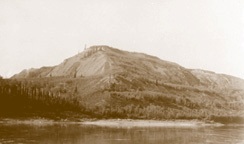Saoyú-ʔehdacho facts for kids
Quick facts for kids Saoyú-ʔehdacho |
|
|---|---|
| Lua error in Module:Location_map at line 420: attempt to index field 'wikibase' (a nil value). | |
| Location | Northwest Territories, Canada |
| Governing body | Parks Canada, Déline First Nation |
| Official name: Saoyú-ʔehdacho National Historic Site | |
| Designated | 1997 |
Saoyú-ʔehdacho (also known as Grizzly Bear Mountain and Scented Grass Hills) is a very special place in the Northwest Territories, Canada. It's made up of two land areas that stick out into Great Bear Lake, like two big fingers of land.
This site is known as a cultural landscape. This means it's a place where nature and human history are deeply connected. It's super important to the Sahtu people because they see it as sacred land. Many of their stories and traditions, called oral histories, are about this place.
Contents
What Makes Saoyú-ʔehdacho Special?
Saoyú-ʔehdacho is huge, about 5,587 square kilometers. That's roughly the same size as Prince Edward Island! It includes two main parts: Saoyú (which means Grizzly Bear Mountain) and ʔehdacho (which means Scented Grass Hills).
The Mountains and Hills
Both Saoyú and ʔehdacho have flat tops. Saoyú is about 725 meters (2,379 feet) above sea level, and ʔehdacho is about 650 meters (2,133 feet) high. Around the edges of these land areas, you can see old beach lines that were formed long ago.
Ancient History and Finds
These old beach lines hold clues about people who lived here thousands of years ago. Scientists have found signs of human life from over 5,000 years ago, even before Europeans arrived. This shows how long people have been connected to this land.
A National Historic Site
Saoyú-ʔehdacho was named a National Historic Site in 1997. This was because the land, its cultural treasures (like old graves, trails, and cabins), and the Sahtu people's stories help us understand their way of life. They also show how the Sahtu Dene people used the land and what they believed.
Protecting the Land
To keep this special place safe, the Canadian government took steps to protect it. In 2001 and 2005, they stopped new mining claims or other activities that could harm the land.
In 2007, Parks Canada and the Déline First Nation agreed to work together. They decided to protect and manage the site as a team. Most of the land (80%) was officially given to Parks Canada in 2009. Then, in 2011, even stronger rules were put in place to protect the site under the National Parks Act.
Unique Facts About the Site
Saoyú-ʔehdacho is the largest National Historic Site in Canada by land size. It's also special because:
- It was the first National Historic Site chosen and protected after talking with Indigenous peoples.
- It's the first National Historic Site in Northern Canada that Parks Canada manages together with an Indigenous group.
- It's the first National Historic Site in the Northwest Territories where Parks Canada is involved in its care.
- It's the first cultural landscape in Northern Canada recognized by the Government of Canada.
This site was also the first to be protected under the Northwest Territories' Protected Areas Strategy. This strategy is a plan made with governments, Indigenous groups, and others to create a network of protected areas across the territory.
What Does the Name Mean?
The name "Saoyú-ʔehdacho" comes from the Slavey language.
- "Saoyú" means "belonging to the bear."
- "ʔehdacho" means "big point."
When the site was first named in 1997, it was called Scented Grass Hills and Grizzly Bear Mountain. Over time, the name was changed to better match the original Slavey language. In 2010, the people who manage the site together, including Parks Canada and the Déline First Nation, agreed on the current spelling: Saoyú-ʔehdacho. This new name was officially approved later that year.


